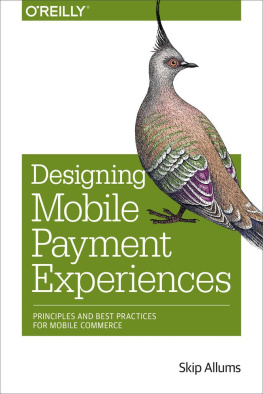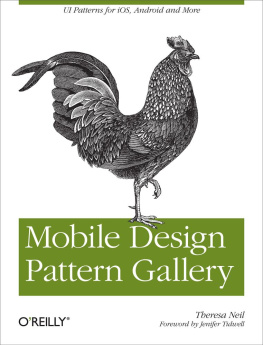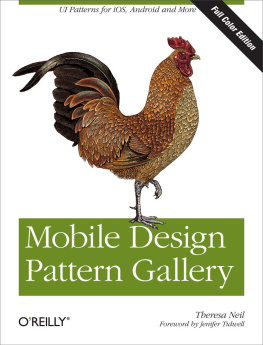All rights reserved.
Published by OReilly Media, Inc., 1005 Gravenstein Highway North, Sebastopol, CA 95472.
OReilly books may be purchased for educational, business, or sales promotional use. Online editions are also available for most titles (.
November 2011: First Edition.
Revision History for the First Edition:
2011-10-25 First release
See http://oreilly.com/catalog/errata.csp?isbn=0636920013716 for release details.
Nutshell Handbook, the Nutshell Handbook logo, and the OReilly logo are registered trademarks of OReilly Media, Inc. Designing Mobile Interfaces , the image of a lovebird, and related trade dress are trademarks of OReilly Media, Inc.
Many of the designations used by manufacturers and sellers to distinguish their products are claimed as trademarks. Where those designations appear in this book, and OReilly Media, Inc. was aware of a trademark claim, the designations have been printed in caps or initial caps.
While every precaution has been taken in the preparation of this book, the publisher and authors assume no responsibility for errors or omissions, or for damages resulting from the use of the information contained herein.
[TI]

O'Reilly Media
Preface
The fact that you are reading this book means you dont need to be told how ubiquitous mobile is, how quickly the mobile market is growing and changing, and how much mobile computing is supplanting desktop computing as well as more traditional media such as film, television, radio, newspapers, and books.
Mobile is so huge and is growing so fast that astonishing growth numbers from just a few years ago pale in comparison to growth numbers todayso much so that we wont even bother quoting any figures, as they will be outdated long before the rest of the content loses its relevance.
One thing that has not happened yet is true standards for design. Movements are now underway to design for the mobile experience first, before focusing on other forms of computing. A good reason for this is that in many markets, many of your customers look at your website on mobile devices more than on desktops.
Yet, too much design is based on older paradigms for the desktop, or even for TV or print. Within mobile, too many design discussions are very narrowly focused. They pay special attention to applications on a single platform, or only to the mobile weband almost always at the expense of every other platform. Certainly, almost no one discusses anything but smartphones, despite the huge market share and vast usage rates of feature phones.
Fragmentation is discussed as a bad thing for marketing, and sometimes for design, but designers themselves contribute to this fragmentation too often by focusing on pixel-based layouts and the specifics of their favorite OS. This does no one any good, and is especially pointless when you consider the user. Devices generally have many more features and methods of interaction in common than their differences might imply.
Serious mobile design now, and especially in the future, will require building for every user, and providing some solution on every platform.
This book offers a set of common patterns for interaction design on all types of mobile devices. A few patterns require specific hardware or form factors, but most are absolutely universal.
Most do not concern themselves at the top level with implementation details. The correct solution is correct even at the OS level, as an application or as a website.
Of course, there are notes to discuss alternatives, methods, and limitations to assist with decision making. And many of the specific patterns are coupled with alternatives or variations that allow similarly useful solutions to be achieved on any type of device.
Who This Book Is For
As with any good form of interactive design, we have kept a specific scope in mind from the moment we started writing this book. If this book was intended to be all things to all people, it would be much larger or wed simply never have finished it. Our focus here has been on design. By this we mean information architecture; information, interaction, interface, and visual design; and copywriting.
If your job title, job description, or deliverables have names like those just mentioned, and you work in mobile, you need this book. Whether you are working on apps or websites for mobile (or any of many other things), this book addresses the common underlying principles in order to help you make better decisions and understand how to create better designs.
If you are moving from another field, such as desktop web design, or are switching from one narrowly focused mobile area to another, this book encompasses general patterns that can help you understand how to move from one type of device or one type of interaction to another.
If you work in a related job, this book still has something for you. Human factors engineers and HCI experts will find numerous discussions of why these solutions have become patterns, and references to cognitive psychology- and physiology-based reasons these are true.
Development is not addressed as such, but the book is organized so that you can use it to find specific solutions to any form of mobile interaction. If you dont have a dedicated design team, you can use the patterns to find and focus on solutions, confirm they are technically possible, and avoid common implementation pitfalls.
Hardware designers, or anyone who can influence hardware design, will find specific guidelines to best practices in interactive, such as key labels and the use of sensors. Though these are included primarily for use by interaction designersto understand how the hardware influences their on-screen behaviorsthey are also specific enough to be used for design of the interactive portions of the hardware itself.
What We Mean by Mobile
Over the years, the reaction to my job title, mobile interaction designer, has migrated from blank stares to significant interest in this suddenly mainstream technology. Still, only about half the time do people have any idea what that title means. And if they do, they almost always assume my job is to design mobile phones or apps for them.
Figure 1. Traditional media, and desktop computing, require the user to make an effort to go to where the display is; even a laptop requires creating an ad hoc workplace. When the mobile device is always with you, everywhere is a place to do work, be entertained, or consume information.
Occasionally, someone asks if we also design games for the Nintendo DS, or make maps for GPS navigation, or do work for some other sort of device. Has the definition of mobile changed? This is a list of the types of things we looked at to find and validate these patterns:












